Seismic Performance of Drained Piles in Layered Soils
Abstract
:1. Introduction
2. Drainage Piles: Concept and Prototypes
2.1. General Concept
2.2. Model-Scale Drainage Piles
2.3. Shaking Table Tests
2.3.1. Model Geometry and Materials
2.3.2. Instrumentation
2.3.3. Test Configurations
2.3.4. Ground Motion and Scaling
3. Shake Table Results and Analysis
3.1. Comparison of Shaking-Induced Discharge Flow Volumes
3.2. Comparison of Excess Pore Pressure Generation and Dissipation
3.3. Comparison of Acceleration Time Histories
4. Conclusions
- The volume of porewater discharged was dependent on the orientation of the drains relative to the predominant direction of shaking and the number of drains per pile. The efficiency of the drains increased as the orientation of the drains increased from 0° to 90° relative to the direction of shaking. The provision of two drains per pile resulted in a significant increase in the volume of porewater discharged as compared to the singly drained pile, but the incremental increase in discharge volume reduced when doubling the drains again to four per pile.
- Drained piles demonstrated the ability to significantly reduce the magnitude of shaking-induced excess pore pressures in proximity to the drain. The excess pore pressure ratio reduced slightly with an increase in the number of drains per pile; however, the extent of soil with reduced excess pressure increased with the increase in the discharge capacity or number of drains. The orientation of the drain relative to the direction of shaking also influenced the magnitude of excess pore pressure.
- The provision of drains to the model piles resulted in a sharper reduction in post-shaking excess pore pressure, a critical feature for layered soils that include a low-permeability crust, which can inhibit the dissipation of pore pressure and which may result in large post-shaking deformations when the crust is accompanied by sloping ground conditions.
- The amount of porewater discharged and excess pore pressure generated within and near the group of drained piles depended on the position of the pile within the group; however, the soil within the group exhibited relatively low variation in the distribution of excess pore pressure.
- The acceleration time histories observed within the pile-improved soil indicated a coupling of the rate and magnitude of porewater discharge, excess pore pressure generated, and de-amplification of strong ground motion. The amount of de-amplification reduced with increases in the number of drains per pile and corresponding reductions in excess pore pressure. Therefore, removal of excess pore pressure-driven porewater maintains the integrity of the ground motion due to prevention of stiffness degradation associated with liquefaction.
Author Contributions
Funding
Institutional Review Board Statement
Informed Consent Statement
Data Availability Statement
Conflicts of Interest
References
- Hamada, M. Large ground deformations and their effects on lifelines: 1964 Niigata earthquake. In Case Studies of Liquefaction and Lifeline Performance during Past Earthquakes. Vol. 1: Japanese Case Studies; Technical Report NCEER-92-0001; Hamada, M., O’Rourke, T.D., Eds.; National Center for Earthquake Engineering Research: Buffalo, NY, USA, 1992; Volume 1. [Google Scholar]
- Youd, T.L. Liquefaction-Induced Damage to Bridges; Transportation Research Record, Transportation Research Board and the National Research Council: Washington, DC, USA, 1993; Volume 1411, pp. 35–41. [Google Scholar]
- Tokimatsu, K.; Kojima, H.; Kuwayama, S.; Abe, A.; Midorikawa, S. Liquefaction-induced damage to buildings I 1990 Luzon Earthquake. J. Geotech. Eng. 1994, 120, 290–307. [Google Scholar] [CrossRef]
- Bray, J.D.; Dashti, S. Liquefaction induced building movement. Bull. Earthq. Eng. 2014, 2, 1129–1156. [Google Scholar] [CrossRef]
- Cubrinovski, M.; Jacka, M.E.; Bray, J.D.; Ballegooy, S.V.; Malan, P.; O’Rourke, T.D.; Crawford, S.A. Assessment of liquefaction-induced land damage for residential christchurch. Earthq. Spectra 2014, 30, 31–55. [Google Scholar]
- Hamada, M. Performance of Foundations against Liquefaction-induced Permanent Ground Displacements. In Proceedings of the 12th World Conference on Earthquake Engineering, Auckland, New Zealand, 30 January–4 February 2000; p. 8. [Google Scholar]
- Miwa, S.; Ikeda, T.; Sato, T. Damage process of pile foundation in liquefied ground during strong ground motion. Soil Dyn. Earthq. Eng. 2006, 26, 325–336. [Google Scholar] [CrossRef]
- Bhattacharya, S.; Madabhushi, S.P.G.; Bolton, M.D. An alternative mechanism of pile failure in liquefiable deposits during earthquakes. Géotechnique 2004, 54, 203–213. [Google Scholar] [CrossRef]
- Wilson, D.W.; Boulanger, R.W.; Kutter, B.L. Observed seismic lateral resistance of liquefying sand. J. Geotech. Geoenviron. Eng. 2000, 126, 898–906. [Google Scholar] [CrossRef]
- Tokimatsu, K.; Suzuki, H. Porewater Pressure Response around Pile and its Effects on p-y Behavior during Soil Liquefaction. Soils Found. 2004, 44, 101–110. [Google Scholar] [CrossRef] [PubMed]
- Rollins, K.M.; Gerber, T.M.; Ashford, S.A. Lateral resistance of a full-scale pile group in liquefied sand. J. Geotech. Geoenviron. Eng. 2005, 131, 115–125. [Google Scholar] [CrossRef]
- Rollins, K.M.; Hales, L.J.; Ashford, S.A.; Camp, W.M. P-y curves for large diameter shafts in liquefied sand from blast liquefaction tests. In Seismic Performance and Simulation of Pile Foundations; ASCE: Reston, VA, USA, 2005; pp. 11–23. [Google Scholar]
- Li, W.; Chen, Y.; Stuedlein, A.W.; Liu, H.; Zhang, X.; Yang, Y. Performance of X-shaped and Circular Pile-Improved Ground Subject to Liquefaction-induced Lateral Spreading. Soil Dyn. Earthq. Eng. 2018, 109, 273–281. [Google Scholar] [CrossRef]
- Kumar, S. Reducing liquefaction potential using dynamic compaction and construction of stone columns. Geotech. Geol. Eng. 2001, 19, 169–182. [Google Scholar] [CrossRef]
- Adalier, K.; Elgamal, A. Mitigation of liquefaction and associated ground deformations by stone columns. Eng. Geol. 2004, 72, 275–291. [Google Scholar] [CrossRef]
- Mitchell, J.K. In Place Treatment of Foundation Soils. J. Soil Mech. Found. Div. ASCE 1968, 96, 73–110. [Google Scholar] [CrossRef]
- Siegel, T.C.; NeSmith, W.M.; NeSmith, W.M.; Cargill, P.E. Ground Improvement Resulting from Installation of Drilled Displacement Piles. In Proceedings of the 32nd Annual DFI Conference; Deep Foundations Institute: Hawthorne, NJ, USA, 2007; p. 10. [Google Scholar]
- Stuedlein, A.W.; Gianella, T.N.; Canivan, G.J. Densification of Granular Soils using Conventional and Drained Timber Displacement Piles. J. Geotech. Geoenviron. Eng. 2016, 142, 04016075. [Google Scholar] [CrossRef]
- Gianella, T.N.; Stuedlein, A.W. Performance of Driven Displacement Pile-Improved Ground in Controlled Blasting Field Tests. J. Geotech. Geoenviron. Eng. 2017, 143, 04017047. [Google Scholar] [CrossRef]
- Kitazume, M. The Sand Compaction Pile Method; Taylor and Francis Group, PLC.: London, UK, 2005; p. 232. [Google Scholar]
- Aloisio, A.; Contento, A.; Xue, J.; Fu, R.; Fragiacomo, M.; Briseghella, B. Probabilistic formulation for the q-factor of piles with damping pre-hole. Bull. Earthq. Eng. 2023, 21, 3749–3775. [Google Scholar] [CrossRef]
- Panah, A.K.; Khoshay, A.H. A new seismic isolation system: Sleeved-pile with soil-rubber mixture. Int. J. Civ. Eng. 2015, 13, 124–132. [Google Scholar]
- Dobson, T. Case Histories of the Vibro Systems to Minimize the Risk of Liquefaction. In Soil Improvement: A Ten Year Update; ASCE Geotechnical Special Publication: Atlantic, NJ, USA, 1987; pp. 167–183. [Google Scholar]
- Mitchell, J.K.; Baxter, C.D.P.; Munson, T.C. Performance of Improved Ground during Earthquakes, Improvement for Earthquake Hazard Mitigation; ASCE Geotechnical Special Publication: Atlantic, NJ, USA, 1995; pp. 1–36. [Google Scholar]
- Baez, J.I. A Design Model for the Reduction of Soil Liquefaction by Vibro-stone Columns. Ph.D. Thesis, University of Southern California, Los Angeles, CA, USA, 1995; p. 222. [Google Scholar]
- Boulanger, R.W.; Idriss, I.M.; Stewart, D.; Hasbash, Y.; Schmidt, B. Drainage Capacity of Stone Columns or Gravel Drains for Mitigating Liquefaction. Geotech. Spec. Publ. 1998, 75, 678–690. [Google Scholar]
- Filz, G.; Sloan, J.; McGuire, M.; Collin, J.; Smith, M. Column-Supported Embankments: Settlement and Load Transfer. In Geotechnical Engineering State of the Art and Practice; ASCE: Oakland, CA, USA, 2012; pp. 54–77. [Google Scholar]
- Rayamajhi, D.; Nguyen, T.V.; Ashford, S.A.; Boulanger, R.W.; Lu, J.; Elgamal, A.; Shao, L. Numerical study of shear stress distribution for discrete columns in liquefiable soils. J. Geotech. Geoenviron. Eng. 2014, 140, 04013034. [Google Scholar] [CrossRef]
- Rayamajhi, D.; Tamura, S.; Khosravi, M.; Boulanger, R.W.; Wilson, D.W.; Ashford, S.A.; Olgun, C.G. Dynamic Centrifuge Tests to Evaluate Reinforcing Mechanisms of Soil-Cement Columns in Liquefiable Sand. J. Geotech. Geoenviron. Eng. 2015, 141, 04015015. [Google Scholar] [CrossRef]
- Rollins, K.M.; Anderson, J.; McCain, A.; Goughnour, R. Vertical composite drains for mitigating liquefaction hazard. In Proceedings of the 13th International Offshore and Polar Engineering Conference, Honolulu, HI, USA, 25–30 May 2003; pp. 498–505. [Google Scholar]
- Howell, R.; Rathje, E.; Kamai, R.; Boulanger, R. Centrifuge Modeling of Prefabricated Vertical Drains for Liquefaction Remediation. J. Geotech. Geoenviron. Eng. 2012, 138, 262–327. [Google Scholar] [CrossRef]
- Vytiniotis, A.; Whittle, A. Analysis of PVDrains for Mitigation of Seismically Induced Ground Deformations in Sand Slopes. J. Geotech. Geoenviron. Eng. 2017, 143, 9. [Google Scholar] [CrossRef]
- Rollins, K.M.; Price, B.E.; Dibb, E.; Higbee, J.B. Liquefaction mitigation of silty sands in Utah using stone columns with wick drains. In Ground Modification and Seismic Mitigation; ASCE: Oakland, CA, USA, 2006; pp. 343–348. [Google Scholar]
- Rollins, K.M.; Quimby, M.; Johnson, S.R.; Price, B. Effectiveness of stone columns for liquefaction mitigation of silty sands with and without wick drains. In Advances in Ground Improvement: Research to Practice in the United States and China; ASCE: Oakland, CA, USA, 2009; pp. 160–169. [Google Scholar]
- Seed, H.B.; Booker, J.R. Stabilization of Potentially Liquefaction Sand Deposits Using Gravel Drains. J. Geotech. Eng. Div. 1977, 103, 756–768. [Google Scholar]
- Sasaki, Y.; Taniguchi, E. Shaking table tests on gravel drains to prevent liquefaction of sand deposits. Soils Found. 1982, 22, 1–14. [Google Scholar] [CrossRef] [PubMed]
- Matsubara, K. Analysis of gravel drain against liquefaction and its application to design. In Proceedings of the Ninth Conference on Earthquake Engineering, Tokyo and Kyoto, Japan, 2–9 August 1988; pp. 249–254. [Google Scholar]
- Adalier, K.; Elgamal, A.; Meneses, J.; Baez, J.I. Stone columns as liquefaction countermeasure in non-plastic silty soils. Soil Dyn. Earthq. Eng. 2003, 23, 571–584. [Google Scholar] [CrossRef]
- Sadrekarimi, A.; Ghalandarzadeh, A. Evaluation of gravel drains and compacted sand piles in mitigating liquefaction. Ground Improv. 2005, 9, 91–104. [Google Scholar] [CrossRef]
- Kita, H.; Iida, T.; Nishitani, M. Experimental study on countermeasures for liquefaction by steel piles with drain. In Proceedings of the Tenth World Conference on Earthquake Engineering, Madrid, Spain, 19–24 July 1992; pp. 1701–1706. [Google Scholar]
- Pestana, J.M.; Hunt, C.E.; Goughnour, R.R.; Kammerer, A.M. Effect of Storage Capacity on Vertical Drain Performance in Liquefiable Sand Deposits. In Proceedings of the 2nd International Conference on Ground Improvement Techniques, Singapore, 8–9 October 1998; pp. 373–380. [Google Scholar]
- Iai, S.; Koizume, K. Estimation of Earthquake Induced Excess Pore Water Pressure for Gravel Drains. In Proceedings of the 7th Japan Earthquake Engineering Symposium; Kyoto University: Kyoto, Japan, 1986; pp. 679–684. [Google Scholar]
- Tanaka, Y.; Mizoguchi, Y.; Asada, T.; Nomura, T.; Higashi, S.; Masashi, J.; Iwamoto, J. Group Installation of Plastic Board Drains At Embankment Toes for Liquefaction and Lateral Flow Countermeasures. In Proceedings of the 4th International Conference on Earthquake Geotechnical Engineering, Thessaloniki, Greece, 25–28 June 2007; pp. 1519–1527. [Google Scholar]
- Chang, W.J.; Rathje, E.M.; Stokoe, K.H.; Cox, B.R. Direct evaluation of effectiveness of prefabricated vertical drains in liquefiable sand. Soil Dyn. Earthq. Eng. 2004, 24, 723–731. [Google Scholar] [CrossRef]
- Brennan, A.J.; Madabhushi, S.P.G. Liquefaction remediation by vertical drains with varying penetration depths. Soil Dyn. Earthq. Eng. 2006, 26, 469–475. [Google Scholar] [CrossRef]
- Harada, N.; Towhata, I.; Takatsu, T.; Tsunoda, S.; Sesov, V. Development of new drain method for protection of existing pile foundations from liquefaction effects. Soil Dyn. Earthq. Eng. 2006, 26, 297–312. [Google Scholar] [CrossRef]
- Xiang-Ying, W.; Han-Long, L.; Qiang, J.; Yu-Min, C. Field tests on response of excess pore water pressures of liquefaction resistant rigid-drainage pile. Chin. J. Geotech. Eng. 2017, 39, 645–651. (In Chinese) [Google Scholar]
- Xiang-Ying, W.; Yu-Min, C.; Qiang, J.; Han-Long, L. Soil pressures of the anti-liquefaction rigid-drainage pile during pile driving. Rock Soil Mech. 2018, 39, 2184–2192. (In Chinese) [Google Scholar]
- Qiang, J.; Yumin, C.; Xiangying, W.; Hanlong, L. Field tests on squeezing effects of the rigid-drainage pile. China Civ. Eng. J. 2018, 51, 87–94. (In Chinese) [Google Scholar]
- Cubrinovski, M.; Kokusho, T.; Ishihara, K. Interpretation from large-scale shake table tests on piles undergoing lateral spreading in liquefied soils. Soil Dyn. Earthq. Eng. 2006, 26, 275–286. [Google Scholar] [CrossRef]
- Dungca, J.R.; Kuwano, J.; Takahashi, A.; Saruwatari, T.; Izawa, J.; Suzuki, H.; Tokimatsu, K. Shaking table tests on the lateral response of a pile buried in liquefied sand. Soil Dyn. Earthq. Eng. 2006, 26, 287–295. [Google Scholar] [CrossRef]
- Haeri, S.M.; Kavand, A.; Rahmani, I.; Torabi, H. Response of a group of piles to liquefaction-induced lateral spreading by large scale shake table testing. Soil Dyn. Earthq. Eng. 2012, 38, 25–45. [Google Scholar] [CrossRef]
- Motamed, R.; Towhata, R. Shaking table model tests on pile groups behind quay walls subjected to lateral spreading. J. Geotech. Geoenviron. Eng. 2010, 136, 477–489. [Google Scholar] [CrossRef]
- Malvick, E.J.; Kutter, B.L.; Boulanger, R.W. Postshaking Shear Strain Localization in a Centrifuge Model of a Saturated Sand Slope. J. Geotech. Geoenviron. Eng. 2008, 134, 164–174. [Google Scholar] [CrossRef]
- Kokusho, T. Water film in liquefied sand its effect on lateral spread. J. Geotech. Geoenviron. Eng. 1999, 125, 817–826. [Google Scholar] [CrossRef]
- Iai, S. Similitude for shaking table tests on soil-structure-fluid model in 1g gravitational field. Int. J. Rock Mech. Min. Sci. Geomech. 1989, 27, 3–24. [Google Scholar] [CrossRef]
- Pestana, J.M.; Hunt, C.E.; Goughnour, R.R. FEQDrain: A Finite Element Computer Program for the Analysis of the Earthquake Generation and Dissipation of Pore Water Pressure in Layered Sand Deposits with Vertical Drains; Report No. UCB/EERC-97/15 1997; University of California: Berkeley, CA, USA, 1997; p. 91. [Google Scholar]
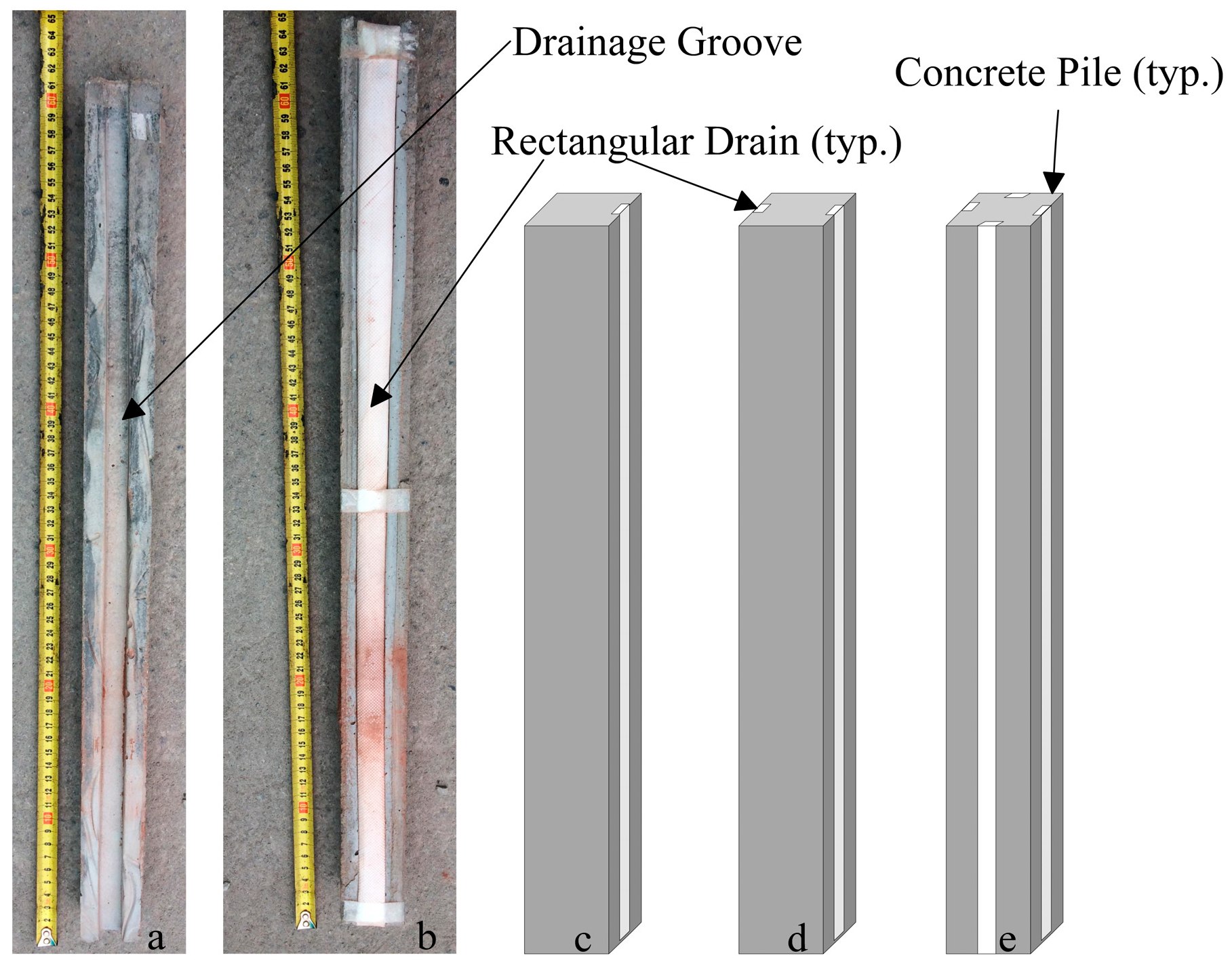
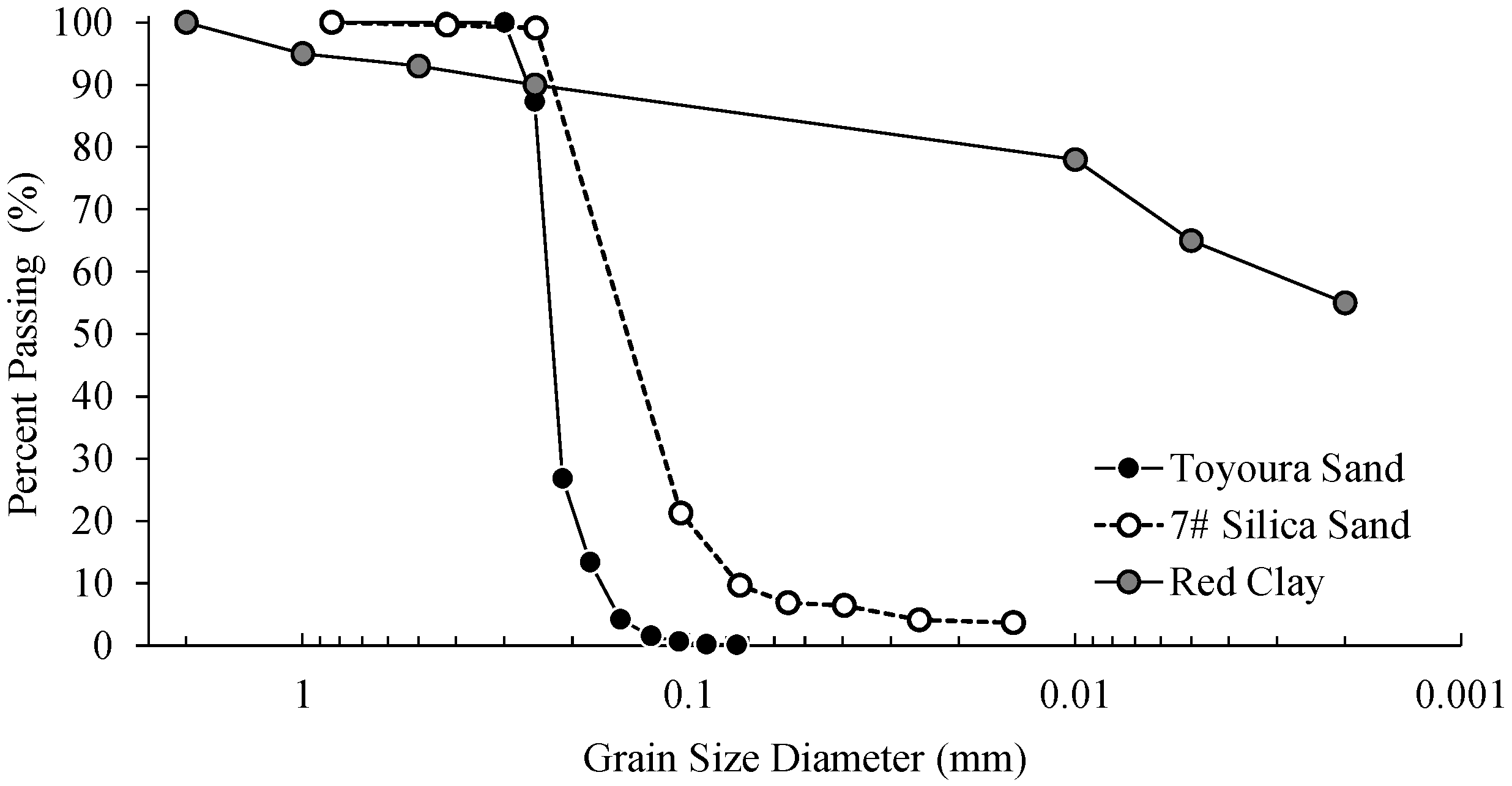
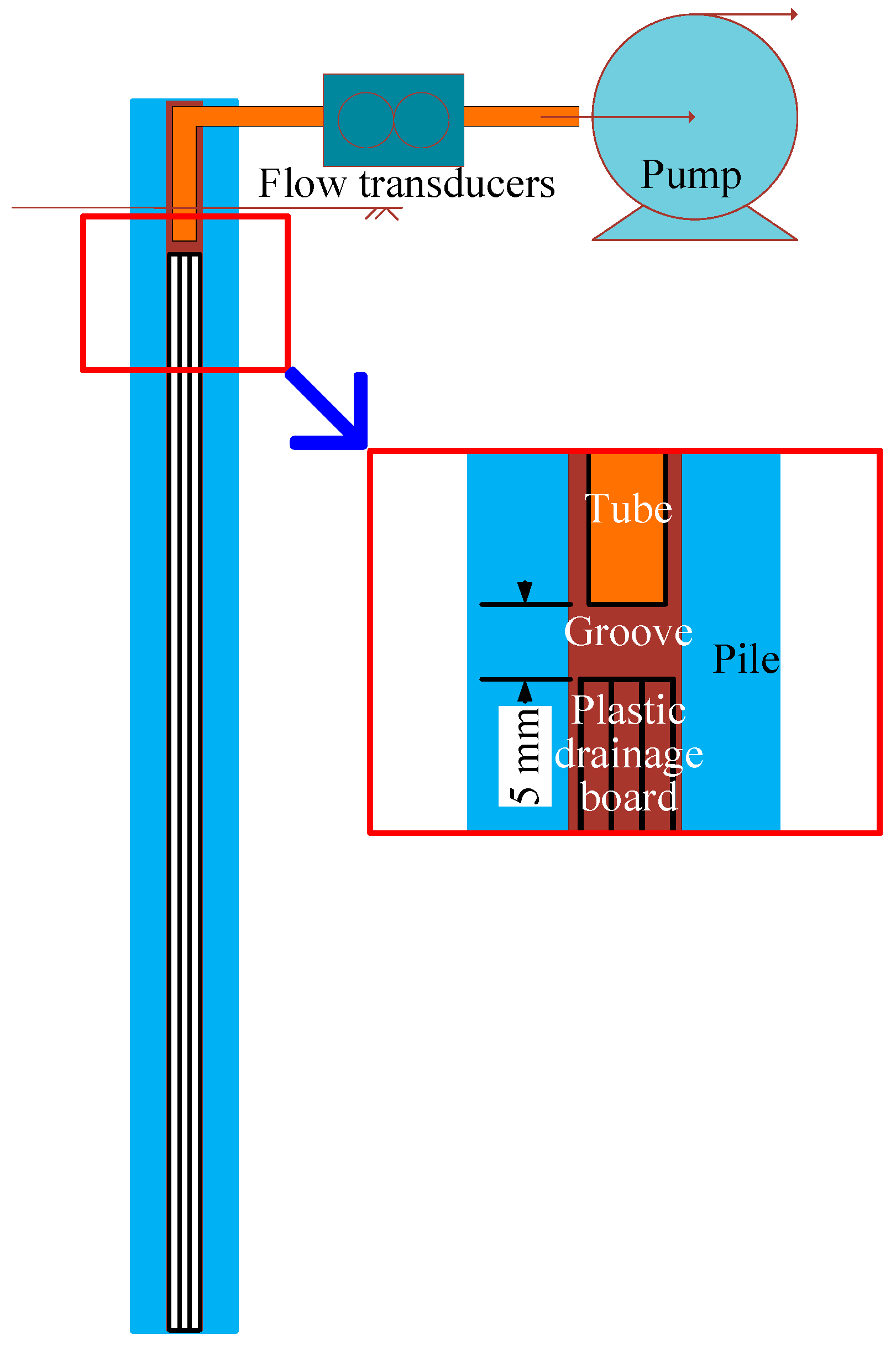

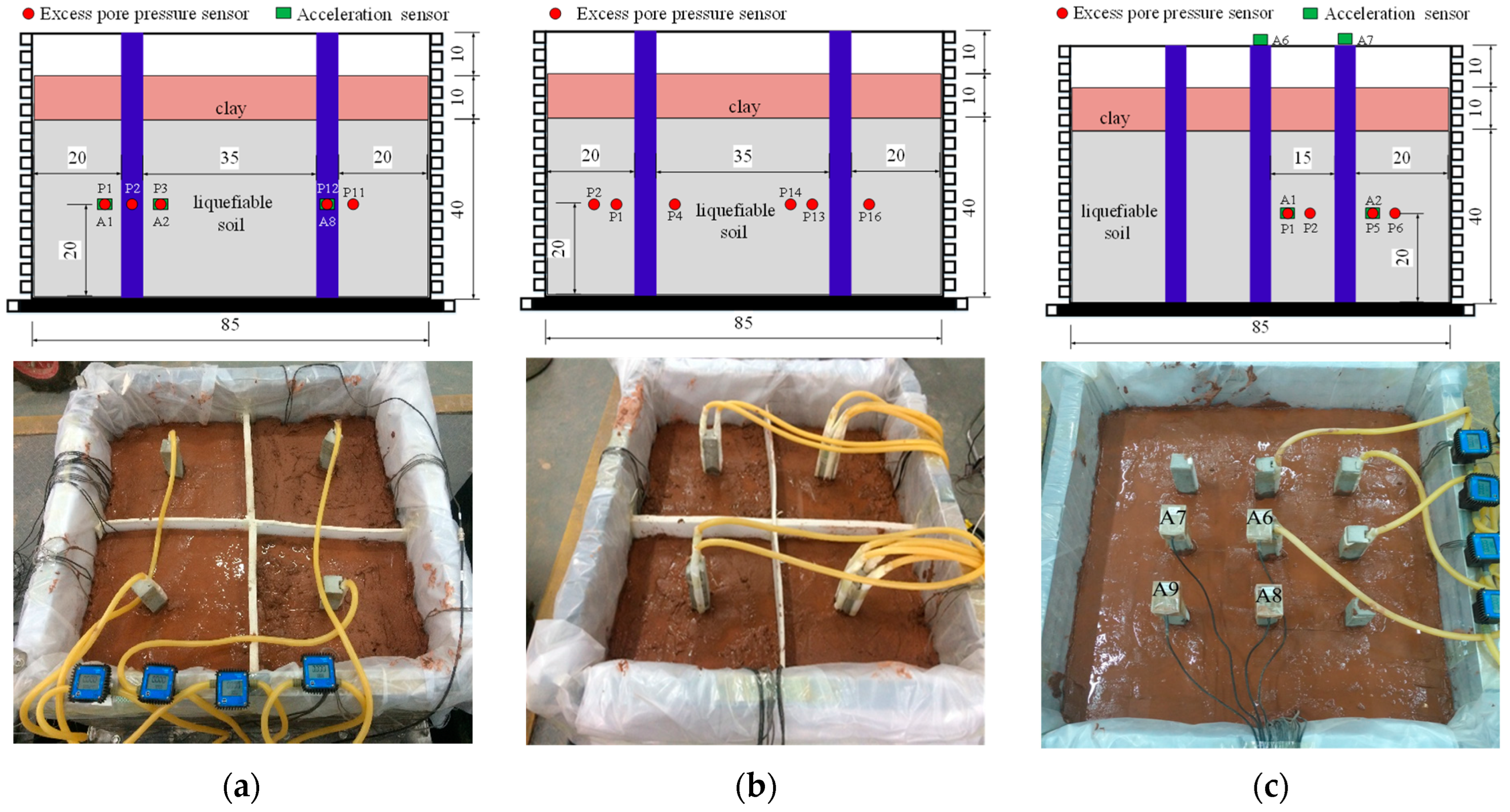
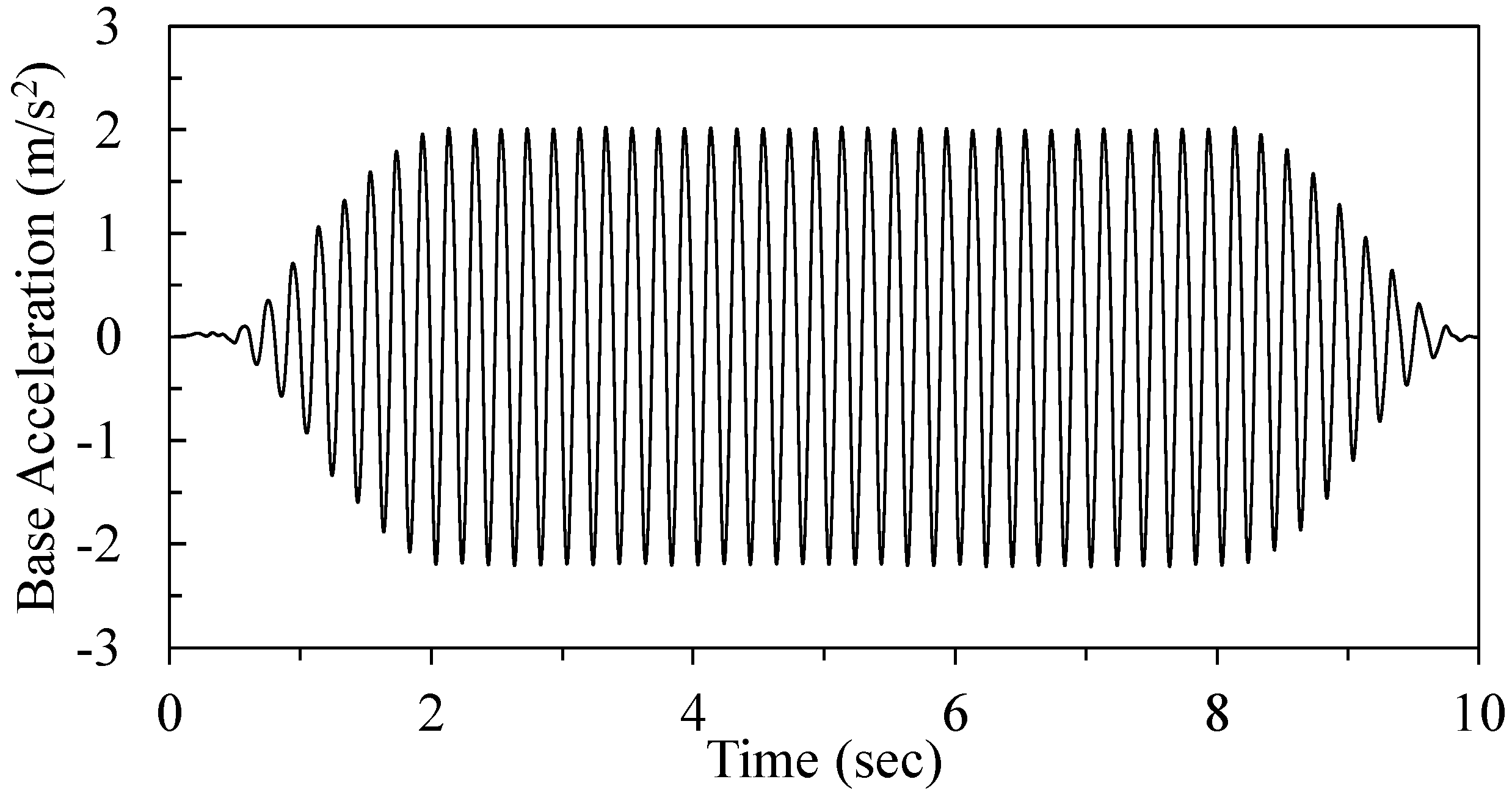
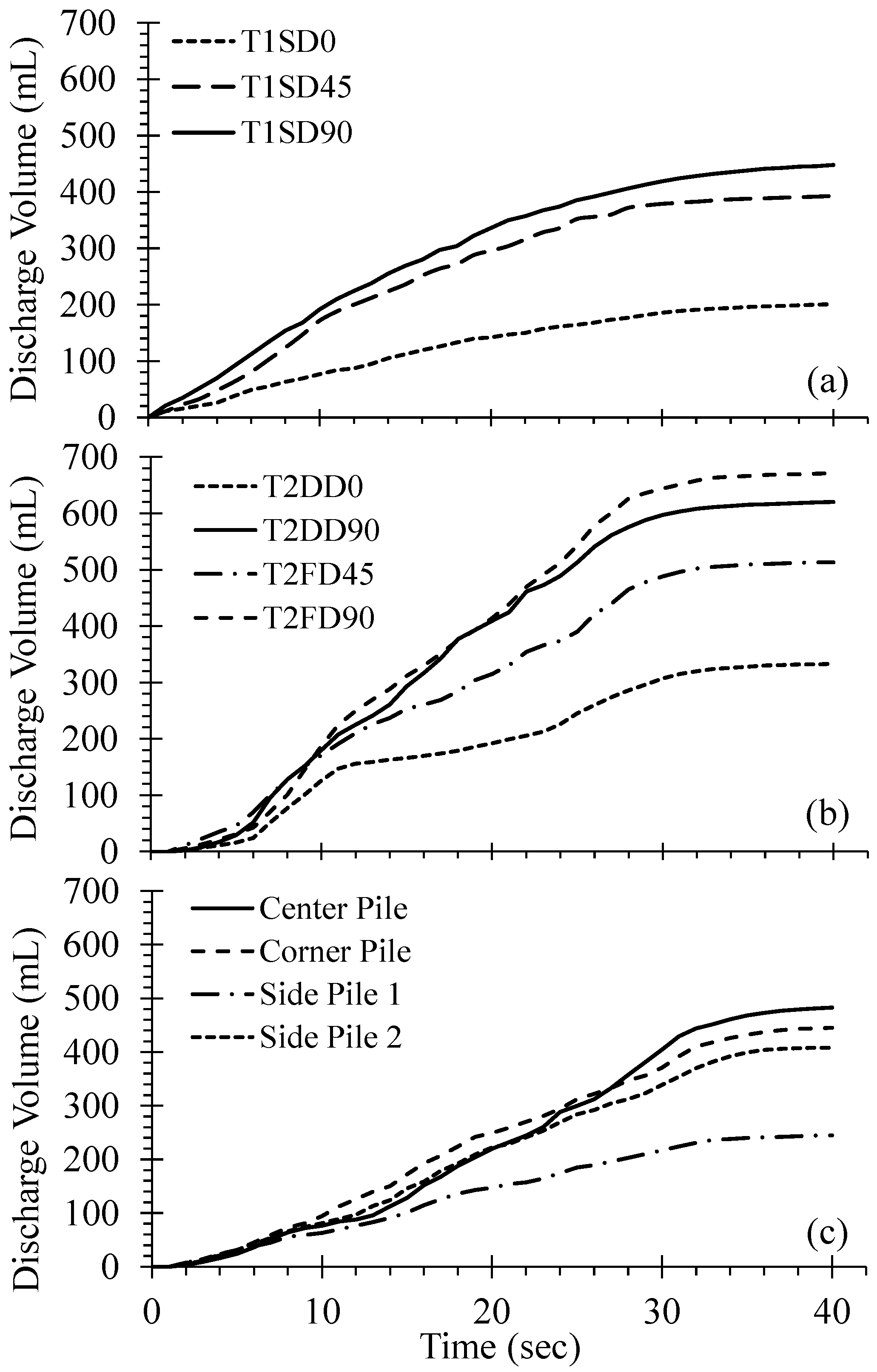
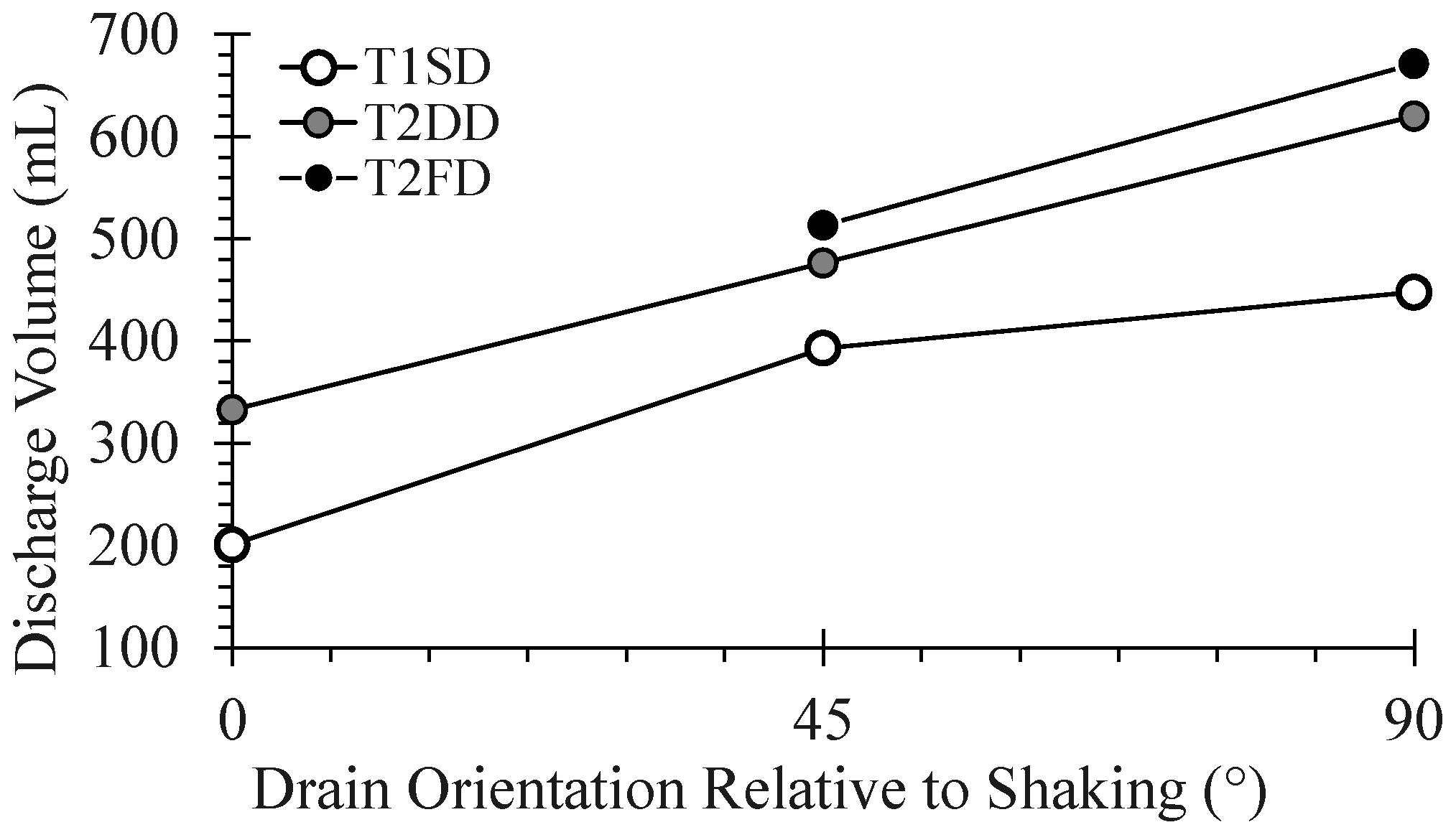
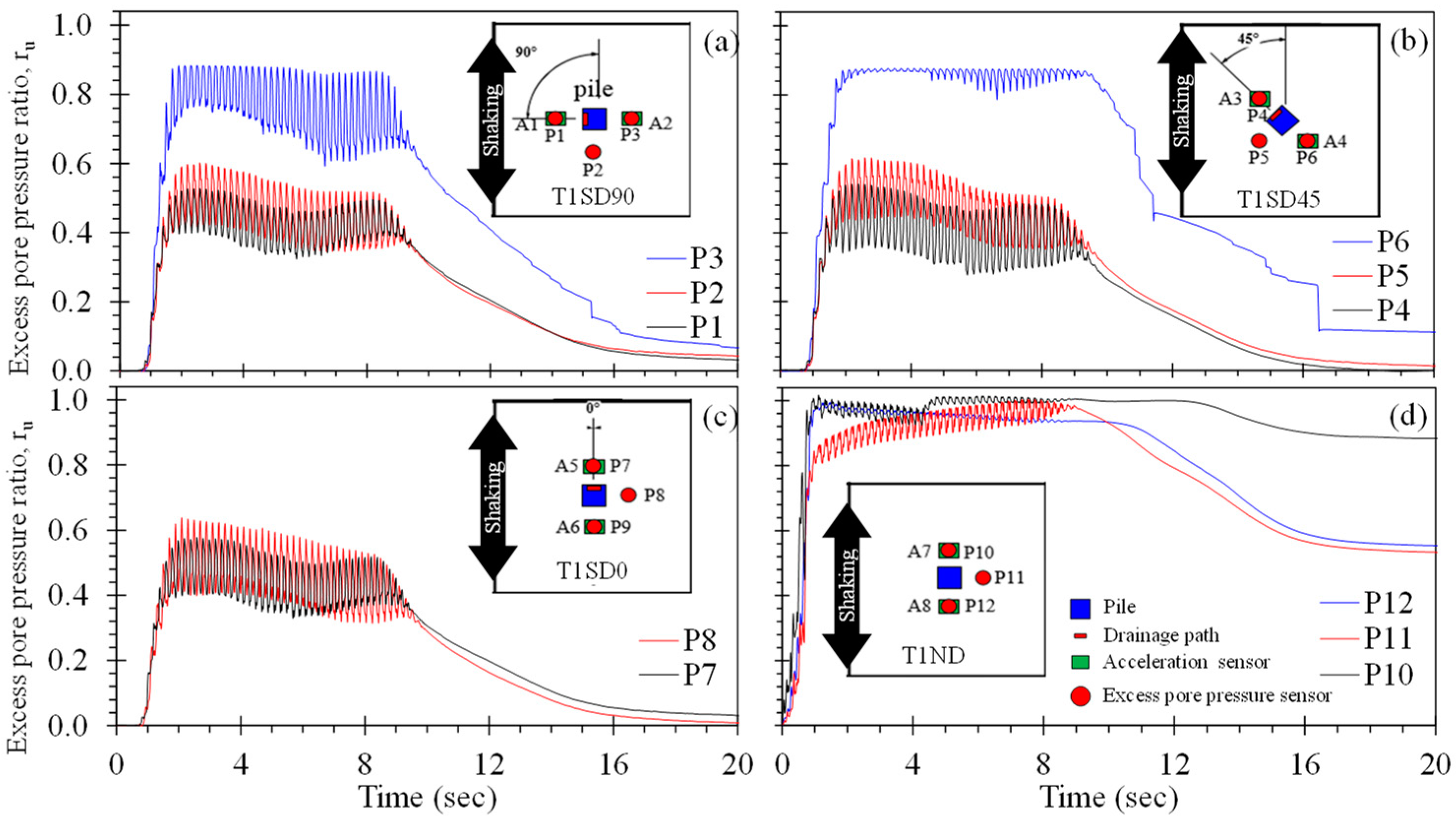
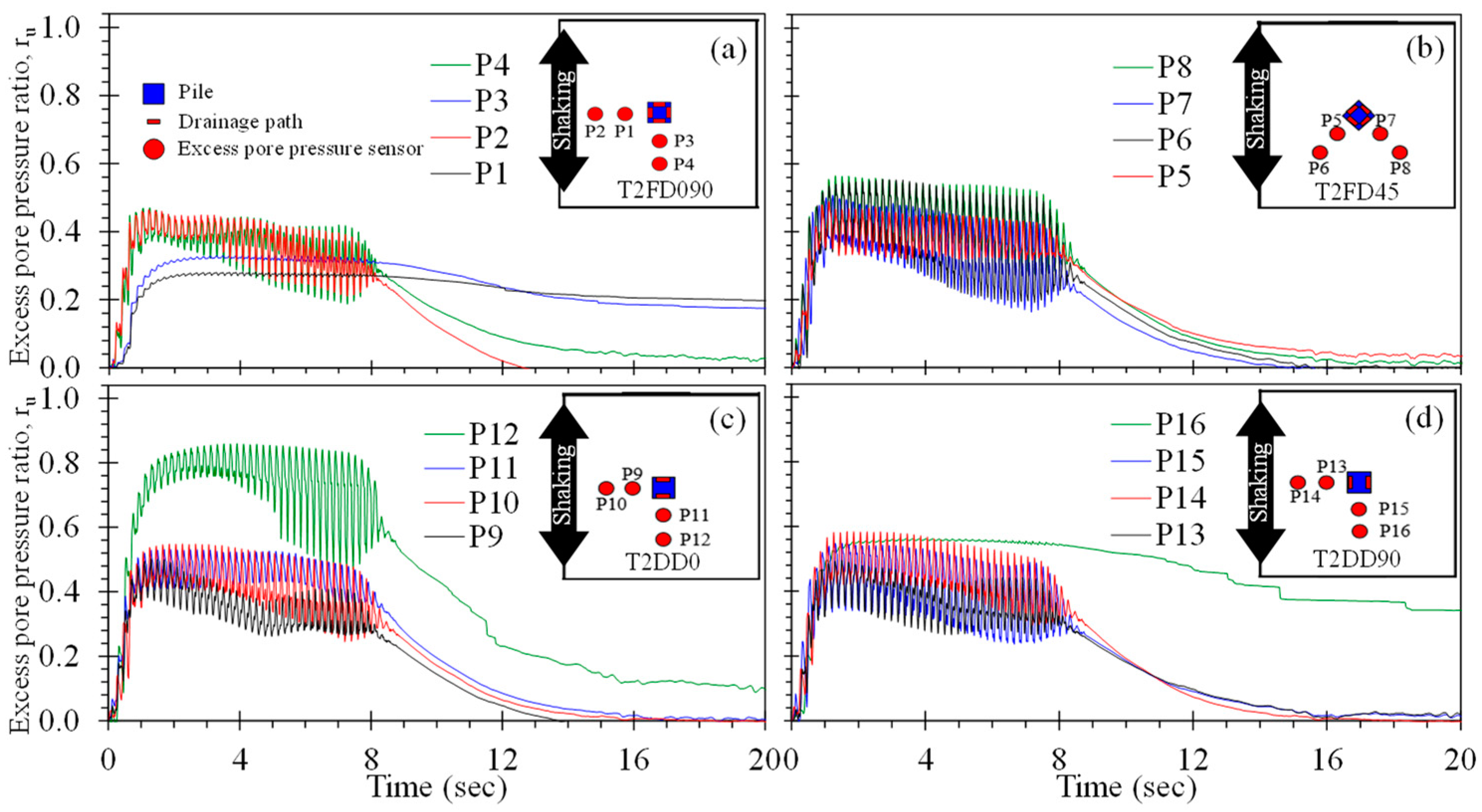
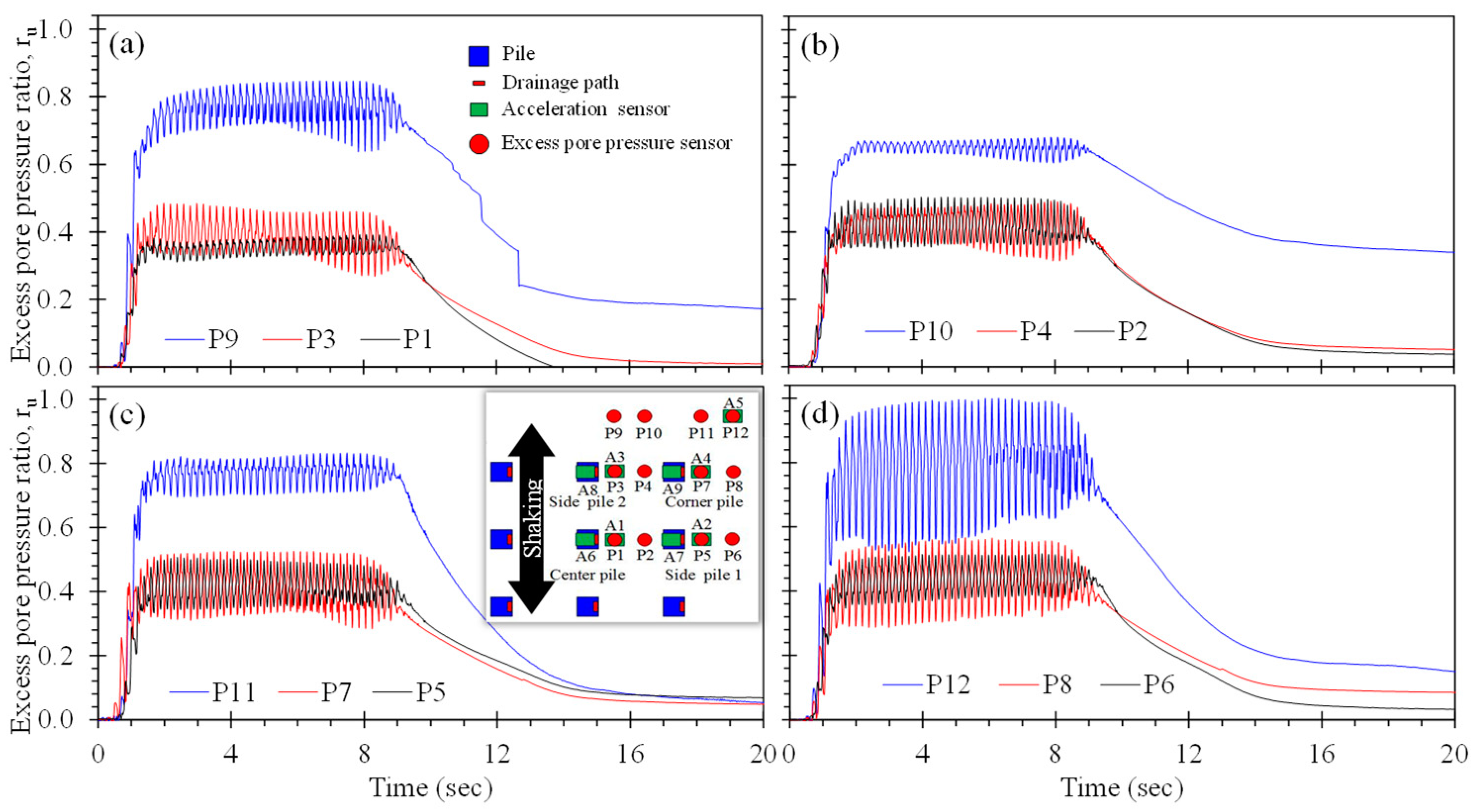
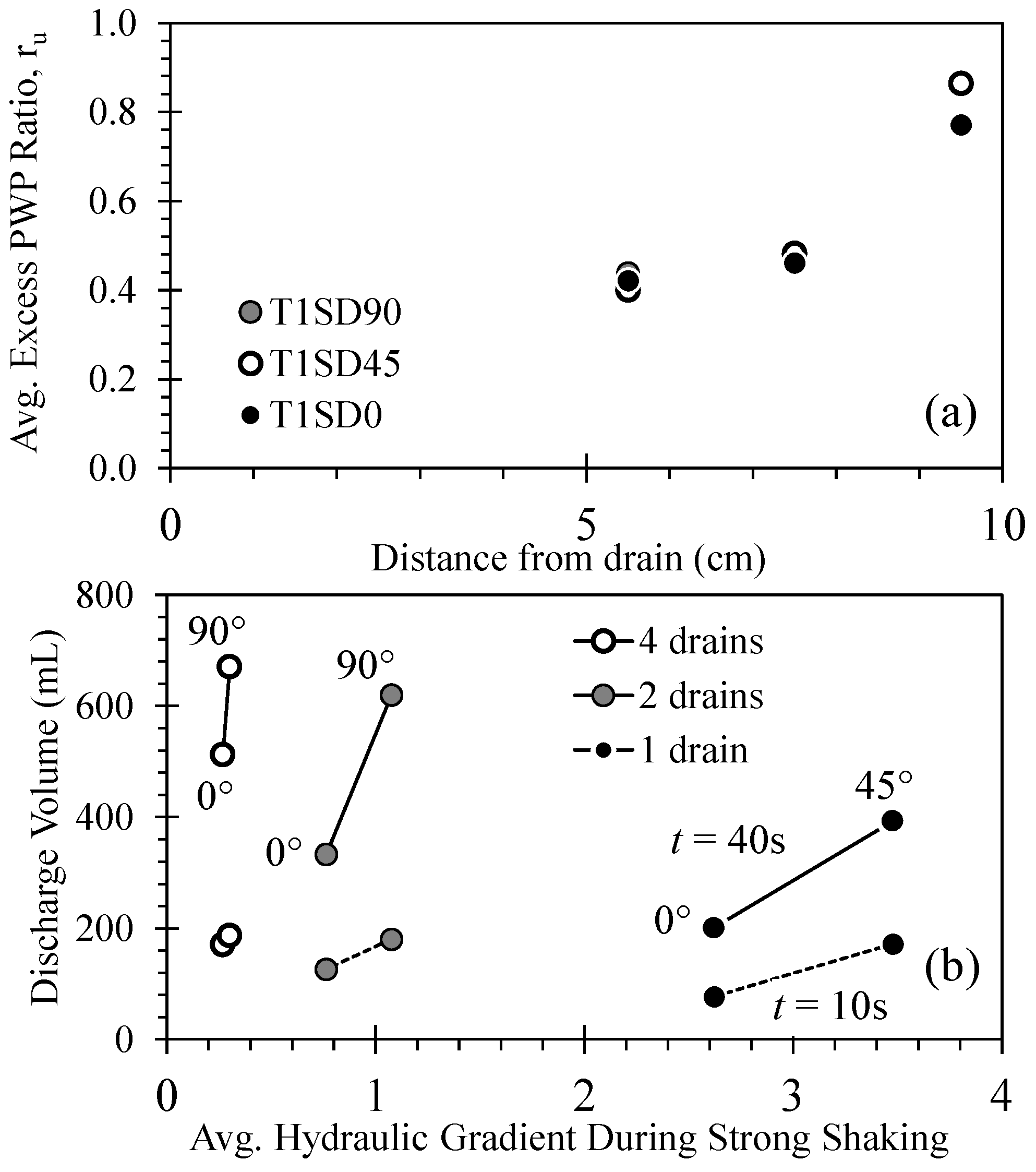
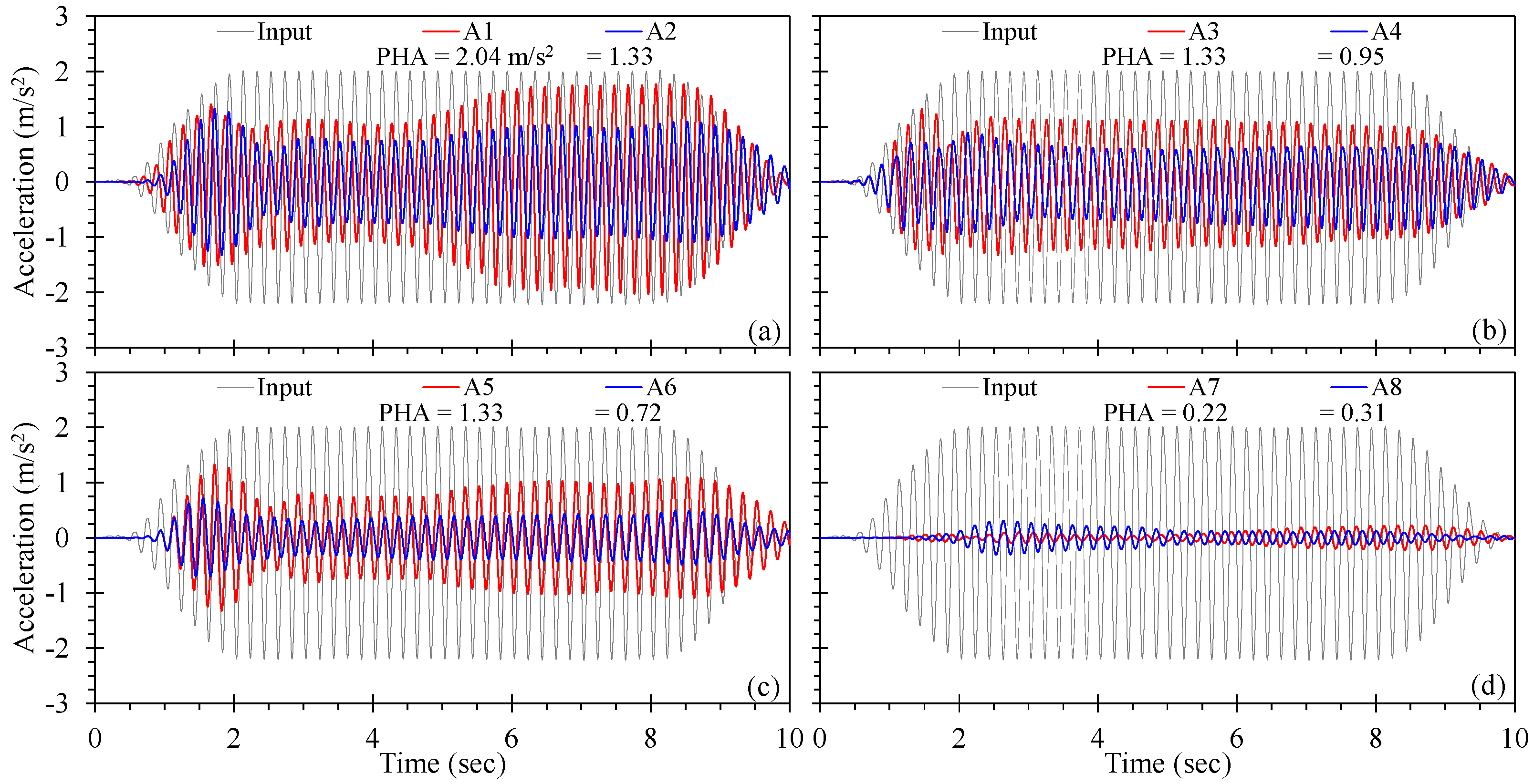
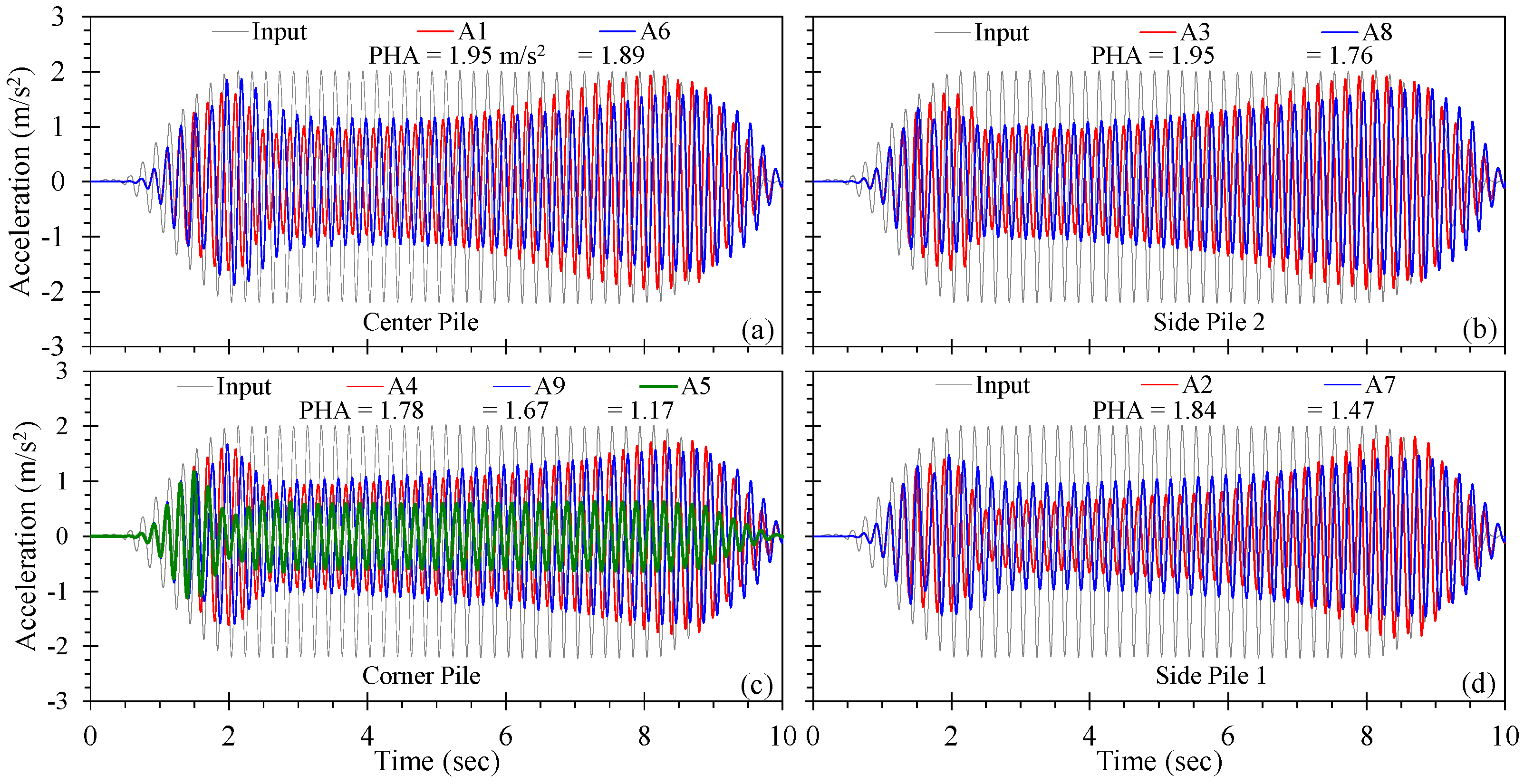
| Shake Table Test Number | Pile Designation | Pile Configuration | Drainage Configuration | Drainage Area (cm2) | Orientation of Drain with Shaking Direction (°) |
|---|---|---|---|---|---|
| T1 | T1ND | Single pile | No drain | 0 | N/a |
| T1 | T1SD0 | Single pile | Single drain | 90 | 0 |
| T1 | T1SD90 | Single pile | Single drain | 90 | 90 |
| T1 | T1SD45 | Single pile | Single drain | 90 | 45 |
| T2 | T2DD0 | Single pile | Double drain | 180 | 0 |
| T2 | T2DD90 | Single pile | Double drain | 180 | 90 |
| T2 | T2QD090 | Single pile | Quad drain | 360 | 0, 90 |
| T2 | T2QD45 | Single pile | Quad drain | 360 | ±45 |
| T3 | T3GSD90 | Group of piles | Single drain | 810 | 90 |
| Items | Model | Prototype |
|---|---|---|
| Scaling factor | 1 | n |
| Length | 1/n | 1 |
| Density | 1 | 1 |
| Displacement | 1/n | 1 |
| Stress | 1 | 1 |
| Frequency | 1/n0.5 | 1 |
| Acceleration | 1 | 1 |
Disclaimer/Publisher’s Note: The statements, opinions and data contained in all publications are solely those of the individual author(s) and contributor(s) and not of MDPI and/or the editor(s). MDPI and/or the editor(s) disclaim responsibility for any injury to people or property resulting from any ideas, methods, instructions or products referred to in the content. |
© 2023 by the authors. Licensee MDPI, Basel, Switzerland. This article is an open access article distributed under the terms and conditions of the Creative Commons Attribution (CC BY) license (https://creativecommons.org/licenses/by/4.0/).
Share and Cite
Yang, Y.; Xin, G.; Chen, Y.; Stuedlein, A.W.; Wang, C. Seismic Performance of Drained Piles in Layered Soils. Materials 2023, 16, 5868. https://doi.org/10.3390/ma16175868
Yang Y, Xin G, Chen Y, Stuedlein AW, Wang C. Seismic Performance of Drained Piles in Layered Soils. Materials. 2023; 16(17):5868. https://doi.org/10.3390/ma16175868
Chicago/Turabian StyleYang, Yaohui, Gongfeng Xin, Yumin Chen, Armin W. Stuedlein, and Chao Wang. 2023. "Seismic Performance of Drained Piles in Layered Soils" Materials 16, no. 17: 5868. https://doi.org/10.3390/ma16175868
APA StyleYang, Y., Xin, G., Chen, Y., Stuedlein, A. W., & Wang, C. (2023). Seismic Performance of Drained Piles in Layered Soils. Materials, 16(17), 5868. https://doi.org/10.3390/ma16175868







